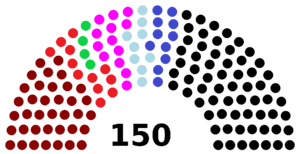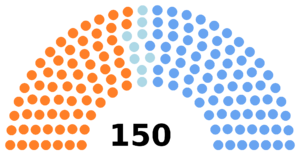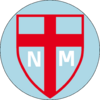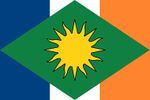1721 Vegno Elections
| |||||||||||||||||||||||||||||||||||||||||||||||||||||||||||||||||||||||||||||||
| |||||||||||||||||||||||||||||||||||||||||||||||||||||||||||||||||||||||||||||||
| Turnout: 3,084,956 (88% of entitled) | |||||||||||||||||||||||||||||||||||||||||||||||||||||||||||||||||||||||||||||||
The 1721 AN Vegno Elections were the fifth ever general elections of the Republic of Vegno and saw the election of the President of the Republic of Vegno and the composition of the Parliament, the Assemblea Nazionale.
The Parliament met for the first session of the fourth legislature on early 1722 AN. Following the constitutional reform approved in 1708 by the Mancuso I Cabinet, each legislature will last five years.
As the General Election of Vegno, population voted both for the President of the Republic, with the two most voted candidates accessing the final ballot a week after, and for the composition of the Parliament, which reflected the formation of the new government.
Antonio Visciglia was elected as President of the Republic of Vegno and Partito Nazionalista Vegnese was the most voted party.
Voting system
The electoral law in force is the "Rinaldellum", which regulated the previous elections of 1709 and provides for a mixed electoral system, where:
- 81,33% of the seats (122 of 150 in the Assemblea Nazionale) are assigned through the proportional system in multi-member constituencies on the basis of blocked lists; the allocation of seats is carried out at regional levels.
- 18,66% of the seats (28 of 150) are assigned with a single-round majority system (2 seats for the two most voted party in each single region;
In accordance with the Constitution, modified by the Mancuso I Cabinet 150 deputies are elected. Furthermore, the composition of the parliament and the mandate of President of the Republic will now last for five years instead of three.
The voting paper, which is a single one for the majority and the proportional systems, shows the names of the candidates to single-member constituencies and in close conjunction with them the symbols of the linked lists for the proportional part, each one with a list of the relative candidates. The voter is able to cast their vote in three different ways, among them:
- Drawing a sign on the symbol of a list. In this case, the vote extends to the candidate in the single-member constituency that is supported by that list.
- Drawing a sign on the name of the candidate of the single-member constituency and another one on the symbol of one list that supports them; the result is the same as that described above. Under penalty of annullment, the panachage is not allowed, so the voter cannot vote simultaneously for a candidate in the uninominal constituency and for a list which is not linked to them.
- Drawing a sign only on the name of the candidate for the uninominal constituency, without indicating any list. In this case, the vote is valid for the candidate in the single-member constituency and also automatically extended to the list that supports them; however, if that candidate is connected to several lists, the vote is divided proportionally between them, based on the votes that each one has obtained in that constituency.
Background
The political framework in which the 1721 elections take place is very peculiar and never experienced in the history of Vegno. The political elections of 1716 had seen a clear victory for the PNV party, an extreme right-wing party headed by Mickey Lange Levati, who was very firmly opposed to the moderate parties protagonists of the electoral scandal of 1716.
The outgoing government was in fact fully led by the PNV, with a slight support from the I Verdi, with Mickey Lange Levati who based all the government's actions on a significant increase in military spending, entry into the Raspur Pact, and the expansion of Vegnese influence on Micras through the occupation of new territories, as occurred in Operation Flying Cormorant and the establishment of the first Vegnese colony on Keltia.
The main criticisms from the opposition were of a limited interest by the right-wing government in major public works, in which the moderates took the lead, and in the poorer section of the population, supported above all by the Communist Party.
Despite these great criticisms by the opposition, which however proved to be very disunited during the legislature, the government enjoyed a large and solid parliamentary base which allowed it to remain in office until the end of the legislature for the 5 years foreseen. arriving at the new elections with still the favors of the polls.
In fact, the polls held during the first months of 1721 showed how, albeit with a slight drop, due to a part of the population not fully satisfied, they saw the PNV as having a clear advantage over the other parties, with however an important doubt as to whether they will be capable of autonomously forming a new government.
Electoral campaign
However, the great expectation for the new elections also brought with it a picture of great uncertainty, in which the only security was represented by the right-green coalition, made up of the previous parties in government: the PNV and I Verdi. The situation of the opposition parties was very fragmented, with the traditional moderate parties still wanting to detach themselves from their involvement in the electoral scandal and the others not wanting to be associated with them at the same time.


The turning point came in the first weeks of 1721 when Antonio Visciglia, former President of the Republic and Minister of Foreign Affairs, was commissioned by the leading members of his party, the Partito Democratico Costituzionale, to completely reform the party. The resolution - renamed the Summer Resolution or the Taurasi Resolution - reformed the new direction of the party, 'in order to counter the country's nationalist drift with more vigor', creating a 'wide-ranging' political project involving the other opposition parties of democratic and liberal inspiration. In the same week, the leader issued an 'appeal for unity', addressing in particular Vegno Vivo, asking them to recompose in the Democratic Union, a new political formation that could take part in the 1721 elections. The same appeal, not without controversy, was also extended to I Verdi and the Communist Party, urging the former to 'abandon the far-right coalition' and the latter to 'agree to unite in a more heterogeneous party for the good of the country ', as quoted in press releases. During the weeks of the electoral campaign, meetings were therefore organized with the political leaders of the parties of Vegno Vivo, Communist Party and I Verdi to find an agreement for the formation of a united and strong coalition, which could oppose the extremist right.
The meetings with the leaders of the major opposition parties were very fruitful and in the course of III.1716, Antonio Visciglia officially announced the formation of a new centre-left coalition, called the "Unione Democratica" (Democratic Union), based on democratic, liberal and equality and inclusion. The announcement was greeted with great fanfare and polls were immediately positive for this new coalition, which for many voters of opposition parties was the only real way out of the far-right government of the PNV.
However, both the Partito Popolare Vegnese remained outside of this agreement, which still carried the legacy of the Shalva Mancuso electoral scandal on its shoulders and which by now was only relegated to a minority role in fighting for 3% to enter parliament, and Forza Vegno, which was twice the first political force in the country and headed by the two-time President of the Republic Luca Zarrella. The latter revealed in the following weeks that he was actually consulted by Antonio Visciglia, mindful of the government alliances of 1706, 1709 and 1714, but no agreement was found between the two former presidents, given the presence within the coalition of Communist Party, against whom Luca Zarrella had always fought during his political career.

As for the PNV, the leader Mickey Lange Levati and his right-hand man Marco Unno were very impressed by the betrayal of I Verdi, so much so that they defined Peppe Freeda, leader of the environmentalists, as "the worst misfortune that has happened to Vegnese politics" and heavily insulted him during the election rallies all over the country. However, a few weeks after the vote, the PNV found itself in a rather critical condition, having lost a minimal percentage of voters and now finding itself alone without allies in the coalition, with a very complicated prospect of forming a new government.
In fact, the polls showed a growing popularity of the centre-left coalition led by Antonio Visciglia, although the first party in the country still remained the PNV, but with a clearly negative trend.
A decidedly sensational twist occurred during the last two weeks before the vote, when Mickey Lange Levati and Luca Zarrella met in secret inside the villa on the outskirts of Mhazar of Zarrella. The meeting, immediately discovered by journalists, had an important media impact, with rumors of a possible sensational alliance between the two leaders, however promptly denied by their militants. However, the confirmation of these official rumors came a few days later when, in a conference convened by the two secretaries of FV and PNV, they announced on live television the formation of a centre-right coalition, which based its electoral campaign on strong conservative positions of Levati's party especially in foreign policy, where the government had notable successes according to the two leaders, but with particular attention also to that part of the liberal and moderate population, which had remained faithful to democratic principles and the successes of the first vegnese governments.
A few days before the vote, the situation therefore saw the formation of an important bipolarity, with on one side the centre-left coalition Unione Democratica, formed by the Partito Democratico Costituzionale, Vegno Vivo, the Communist Party and I Verdi, headed by Antonio Visciglia and on the other one the center-right coalition, formed by the PNV and Forza Vegno, led instead by the outgoing president Mickey Lange Levati the only ones left to run alone in the elections were Luigi Pandolfi's Partito Popolare Vegnese, the Independentist Party and the Swyndirr Party.
Electoral Lists and Candidates
| Alliance | Lists | Head of Party | Seats at last election | Coalition leader | ||
|---|---|---|---|---|---|---|
| Centre-right coalition | Forza Vegno (FV) | Luca Zarrella | 14 | Mickey Lange Levati | ||
| Partito Nazionalista Vegnese (PNV) | Mickey Lange Levati | 72 | ||||
| Unione Democratica | Vegno Vivo (VV) | Haldi Rinaldi | 13 | Antonio Visciglia | ||
| I Verdi - Peppe Freeda (PF) | Peppe Freeda | 5 | ||||
| Partito Democratico Costituzionale (PDC) | Antonio Visciglia | 9 | ||||
| Partito Comunista (PC) | Tito Bettella | 38 | ||||
| Partito Popolare Vegnese (PPV) | Luigi Pandolfi | 0 | - | |||
| Nazarene Movement (NM) | Orazio Torlo-Marani | 0 | - | |||
| Partito Indipendentista Vegnese (PIV) | Lewis Newhouse | 0 | - | |||
| Swnndyrrr Party (PS) | Michele Angelo Avvicinati | 0 | - | |||
Opinion polling
| Polling firm | Updated | PPV | PDC | PC | VV | PF | PNV | FV |
|---|---|---|---|---|---|---|---|---|
| University of Cossa | I.1721 | 2.7 | 11.6 | 18.5 | 11.7 | 3.6 | 40.5 | 11.4 |
| Termometro Politico | I.1721 | 2.7 | 12.5 | 21.1 | 9.6 | 4.0 | 40.1 | 10.0 |
| TeleV news | II.1721 | 3.9 | 9.5 | 19.2 | 11.2 | 4.2 | 38.8 | 13.2 |
| VAI TG24 | II.1721 | 2.1 | 12.1 | 20.4 | 10.5 | 3.8 | 39.3 | 11.8 |
| Polling firm | Updated | PPV | Unione Democratica | PNV | FV | |||
| University of Cossa | III.1721 | 2.5 | 47.2 | 40.1 | 10.2 | |||
| Termometro Politico | III.1721 | 2.8 | 48.8 | 40.5 | 7.9 | |||
| Polling firm | Updated | PPV | Unione Democratica | Centre-right coalition | ||||
| TeleV news | IV.1721 | 3.1 | 48.5 | 48.5 | ||||
| VAI TG24 | IV.1721 | 3.0 | 48.2 | 48.8 | ||||
| Termometro Politico | IV.1721 | 2.6 | 47.9 | 49.5 | ||||
Parliament Results
Overall Results

Results by party |

Results by coalition | ||||||||
| Coalition | Party | Proportional | Majority | Total seats | |||||
|---|---|---|---|---|---|---|---|---|---|
| Votes | % | Seats | Seats | ||||||
| Centre-right coalition | Partito Nazionalista Vegnese | 1,228,340 | 39.82 | 50 | 14 | 64 | 75 | ||
| Forza Vegno | 275,163 | 8.92 | 11 | – | 11 | ||||
| Unione Democratica | Partito Comunista | 569,072 | 18.45 | 23 | 14 | 37 | 66 | ||
| Vegno Vivo | 313,152 | 10.15 | 13 | – | 13 | ||||
| Partito Democratico Costituzionale | 298,085 | 9.66 | 12 | – | 12 | ||||
| I Verdi | 101,499 | 3.29 | 4 | – | 4 | ||||
| Nazarene Movement | 208,251 | 6.75 | 9 | – | 9 | 9 | |||
| Partito Popolare Vegnese | 80,803 | 2.62 | – | – | – | ||||
| Partito Indipendentista Vegnese | 9,713 | 0.31 | – | – | – | ||||
| Swnndyrrr Party | 878 | 0.03 | – | – | – | ||||
| Total | 3,084,956 | 100 | 122 | 28 | 150 | 150 | |||
Regional results
| Region | FV | PDC | PNV | PPV | PC | VV | PF | SP | NM | PIV |
|---|---|---|---|---|---|---|---|---|---|---|
| Cossa | 9% | 11% | 40% | 2% | 18% | 11% | 3% | – | 6% | – |
| South Coast | 10% | 12% | 40% | 2% | 20% | 10% | 3% | 1% | 2% | – |
| Largoprato | 11% | 9% | 41% | 2% | 21% | 9% | 3% | – | 4% | – |
| Bassovento | 8% | 11% | 38% | 3% | 19% | 9% | 4% | – | 8% | – |
| Compare | 8% | 11% | 38% | 3% | 18% | 11% | 3% | – | 8% | – |
| Mhazar-Campoasciutto | 12% | 9% | 39% | 3% | 17% | 10% | 3% | – | 7% | – |
| Buonriposo | 8% | 9% | 40% | 3% | 18% | 11% | 3% | – | 8% | – |
| Caponord | 8% | 10% | 41% | 2% | 19% | 10% | 3% | – | 7% | – |
| Falange | 7% | 11% | 40% | 2% | 20% | 9% | 4% | – | 7% | – |
| Falangina | 9% | 9% | 39% | 3% | 21% | 10% | 3% | – | 6% | – |
| Falangetta | 7% | 8% | 41% | 4% | 20% | 10% | 3% | – | 7% | – |
| Ponente | 7% | 8% | 40% | 3% | 19% | 11% | 4% | – | 6% | 2% |
| Badia | 9% | 9% | 40% | 3% | 18% | 10% | 3% | – | 7% | 1% |
| Pelago | 10% | 9% | 40% | 3% | 18% | 9% | 3% | – | 8% | 0% |
Uninominal seats
| Region | 1° Uninominal Seat | 2° Uninominal Seat |
|---|---|---|
| Cossa | PNV | PC |
| South Coast | PNV | PC |
| Largoprato | PNV | PC |
| Bassovento | PNV | PC |
| Compare | PNV | PC |
| Mhazar-Campoasciutto | PNV | PC |
| Buonriposo | PNV | PC |
| Caponord | PNV | PC |
| Falange | PNV | PC |
| Falangina | PNV | PC |
| Falangetta | PNV | PC |
| Ponente | PNV | PC |
| Badia | PNV | PC |
| Pelago | PNV | PC |
Presidential Results
First Round
|
| |||||||||||||||||
| |||||||||||||||||
| Coalition | Candidate | Vote Received | % of votes | |
|---|---|---|---|---|
| Centre-right coalition | Mickey Lange Levati | 1,503,503 | 48.90% | |
| Unione Democratica | Antonio Visciglia | 1,281,808 | 41.69% | |
| Nazarene Movement | Orazio Torlo-Marani | 208,251 | 6.77% | |
| Partito Popolare Vegnese | Luigi Pandolfi | 80,803 | 2.63% | |
| Total | 3,074,365 | 100% | ||
Second Round
| Coalition | Candidate | Vote Received | % of votes | |
|---|---|---|---|---|
| Unione Democratica | Antonio Visciglia | 1,543,459 | 50.1% | |
| Centre-right coalition | Mickey Lange Levati | 1,536,903 | 49.9% | |
| Total | 3,086,362 | 100% | ||
Aftermath
Political framework and reactions
The electoral results, at least at the parliamentary level, mirrored the initial pre-voting polls, with a clear surprise, however, at the presidential level. The grand alliance promoted by Antonio Visciglia met with great success from a large slice of the population who opposed the right-wing government, without however recognizing a valid alternative, and found in the Unione Democratica coalition an excellent voting alternative to the PNV. On the other hand, the centre-right coalition came close to achieving an effective majority in parliament, stopping at exactly half of the seats (75 out of 150), but above all it suffered an important defeat in the presidential elections where, albeit for a handful of votes, the will popular moderate joined by rewarding Antonio Visciglia in the second round with less than 10 thousand votes ahead.
The victory in the parliamentary elections of the center right and of the Democratic Union coalition in the presidential elections was, however, a semi-defeat, since the political framework resulting from these elections was the most fragmented and disunited ever seen in the vegnese republican history. On the one hand, in fact, the elected President of the Republic had been Antonio Visciglia, who certainly could not seek an agreement in parliament with the centre-right which had fought so hard during the electoral campaign, making the same mistake as a few years ago; on the other hand, not even the support of the only moderate party outside the coalition, the Nazarene Movement, was sufficient to form a new government, since the centre-right completely monopolized half of the parliament.
Once the only possible agreement for a political government waned, the last option for Visciglia was the formation of a technical executive, headed by the lawyer Angelo Greco, who was entrusted, at the beginning of 1722 and, a full two weeks after the start of the consultations, with the task of forming a technical government of independents and professionals, with task of reforming the electoral law to ensure better electoral political stability than that done by the now obsolete Rinaldellum.
The new Greco I Cabinet, once presented the list of 12 ministers, swore, together with President Antonio Visciglia, the II.1722 AN and obtained, a few days later, the first confidence in parliament, supported by the coalition of Democratic Union (PDC, PC,PF,VV) and by the external support of NM and FV, who agreed to vote in favor only of those urgent provisions concerning the new vegnese Colony on Keltia, which had not yet been ratified by the previous government and on the new electoral law, which represented the ultimate task of this new caretaker government.
International reactions
| ||||||||||||||||||||||||||








